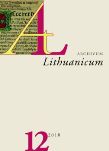Ar Tacito Aestiorumgenies yra estai?
Are Tacit's (Tacitus) Aestiorum Gentes Estonians?
Author(s): Zigmas ZinkevičiusSubject(s): Theoretical Linguistics, Historical Linguistics, Other Language Literature
Published by: Lietuvių Kalbos Institutas
Keywords: Tacit; Aestiorum Gentes; Estonia in historical sources;
Summary/Abstract: In 1998, Estonia commemorated the 1900th anniversary (!) since Estonia was first mentioned in historical sources. It was stated that the Aestiorumgentes , which are mentioned by Roman historian Publius Cornelius Tacitus in his work, Germania 45, 2-4, written in approximately 98 A.D. are Estonians. And this was seemingly the earliest mention of Estonia. This article is devoted to finding out, what arguments help associate the ethnonym aisčiai with the Balts (Lithuanians) and what with the Finnish people (Estonians). The following conclusions have been drawn: 1. In ancient times, the ethnonym aisčiai was used to name one of the tribes of Western Balts. 2. This name is of Baltic origin, even though its etymology has not been completely clarified. 3. Due to the a i > a e > e sound change in Latin, the vowel e appeared in the name of a isčiai. 4. Eventually the ethnonym aisčiai was passed on to the local Finns. While this ethnic group moved towards the North, the name aisčiai > e s t a i was also passed on. In the Middle Ages, it was used by the Scandinavians, who understood it as "inhabitants of Eastern country". 5. Estonians themselves introduced this name only in the middle of the 19th century in connection with the national rebirth.
Journal: Archivum Lithuanicum
- Issue Year: 2010
- Issue No: 12
- Page Range: 345-352
- Page Count: 8
- Language: Lithuanian

